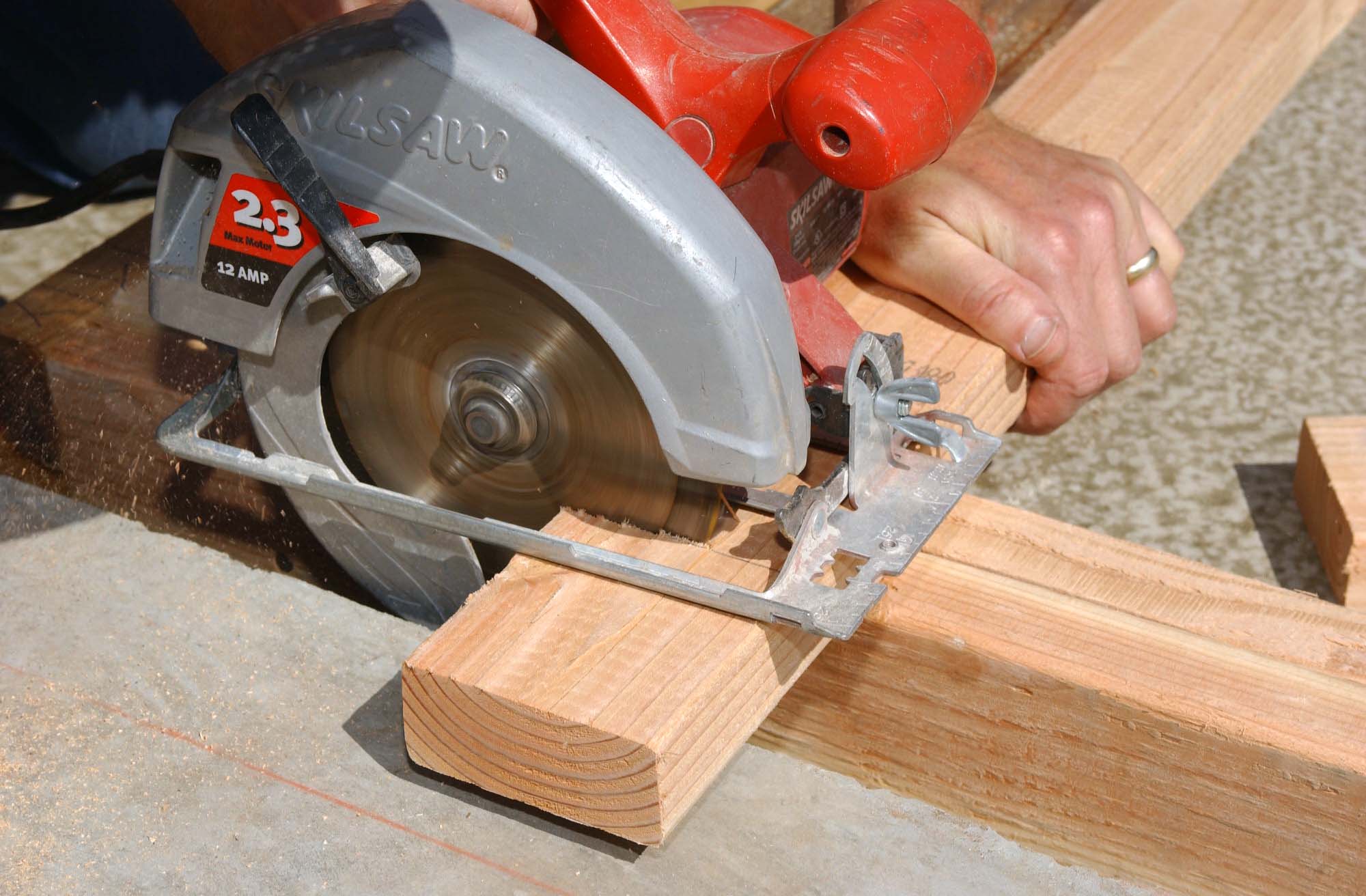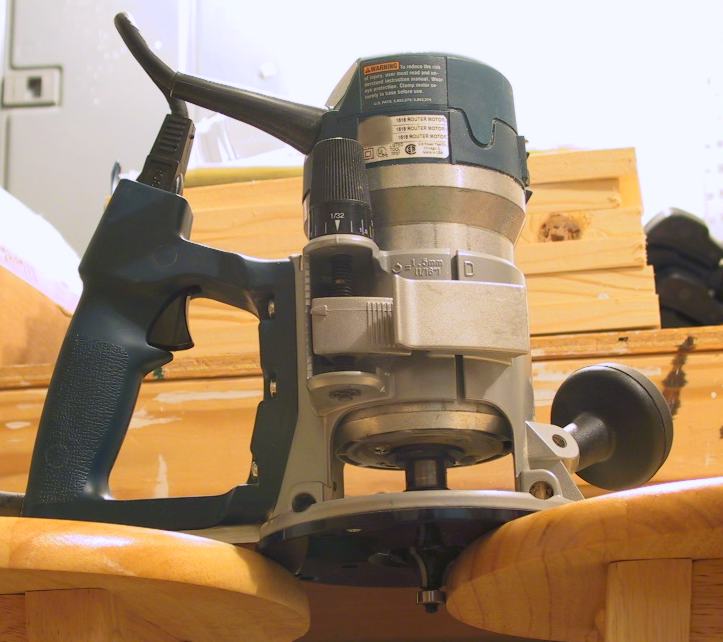|
Plunge Saw
A plunge saw or plunge-cut saw is a type of hand-held circular saw which differs from a regular circular saw in that it can plunge into the material to a predetermined depth during the cut. In other words, the depth-of-cut is not fixed and often can be adjusted to be just slightly over the thickness of the board being cut. This property also allows a plunge saw to cut shallow grooves into the workpiece, if necessary. Compared to traditional hand-held circular saws, plunge saws are said to increase operator safety, as well as allowing for reduced splintering and tear-out. Plunge saws are an essential power tool for joiners, carpenters, kitchen fitters and anyone who works with laminates, insulation or needs to make lots of cuts in small work pieces. History The German power tool manufacturer Festool introduced the first guide rail in 1962, and patented and released the first plunge-cut saw in 1980. Rail systems A track is used to guide the plunge saw. Compatibility The orig ... [...More Info...] [...Related Items...] OR: [Wikipedia] [Google] [Baidu] |
Circular Saw
A circular saw is a power- saw using a toothed or abrasive disc or blade to cut different materials using a rotary motion spinning around an arbor. A hole saw and ring saw also use a rotary motion but are different from a circular saw. ''Circular saws'' may also be loosely used for the blade itself. Circular saws were invented in the late 18th century and were in common use in sawmills in the United States by the middle of the 19th century. A circular saw is a tool for cutting many materials such as wood, masonry, plastic, or metal and may be hand-held or mounted to a machine. In woodworking the term "circular saw" refers specifically to the hand-held type and the table saw and chop saw are other common forms of circular saws. "Skilsaw" and "Skil saw" have become generic trademarks for conventional hand-held circular saws. Circular saw blades are specially designed for each particular material they are intended to cut and in cutting wood are specifically designed for mak ... [...More Info...] [...Related Items...] OR: [Wikipedia] [Google] [Baidu] |
Workpiece
A workpiece is a piece, often made of a single material, that is being processed into another desired shape (such as building blocks). The workpiece is usually a piece of relatively rigid material such as wood, metal, plastic, or stone. After a processing step, the workpiece may be moved on to further steps of processing. For example, a part can made out of bar stock and later become part of a semi-finished product. The workpiece is often attached to the tool being used via a jig or fixture, like for example to a milling machine via an angle plate, or to a lathe via a lathe faceplate. A vise is another example of a simple type of fixture used to fix workpieces. A workpiece may be subjected to various cutting operations, like truing, making fillets, chamfers, countersinking, counterboring, etc. It may also receive various surface treatments and finishes. The term "workpiece" has established itself within crafts and the manufacturing industry, and connects the work or ... [...More Info...] [...Related Items...] OR: [Wikipedia] [Google] [Baidu] |
Splinter
A splinter (also known as a sliver) is a fragment of a larger object, or a foreign body that penetrates or is purposely injected into a body. The foreign body must be lodged inside tissue to be considered a splinter. Splinters may cause initial pain through ripping of flesh and muscle, or infection through bacteria on the foreign object. Splinters commonly consist of wood, but there are many other types, for example, other common types of splinters are glass, plastic, metal, and spines of animals. As with any wound that breaks the skin, splinters can lead to infection, which if left untreated could develop into more serious complications. If a splinter is in the body for more than 2–3 days, or if the wound shows signs of inflammation or tenderness (whether the splinter was removed or not), advice should be sought from a doctor. Getting a splinter Generally, a splinter causes an initial feeling of pain as the sharp object makes its initial penetration through the body. Th ... [...More Info...] [...Related Items...] OR: [Wikipedia] [Google] [Baidu] |
Glossary Of Woodworking
This glossary of woodworking lists a number of specialized terms and concepts used in woodworking, carpentry, and related disciplines. A B C D E F G H I J K L M N P Q R S T U V W References External links Woodworking glossary {{DEFAULTSORT:Glossary Of Woodworking Terms Woodworking Woodworking Woodworking ... [...More Info...] [...Related Items...] OR: [Wikipedia] [Google] [Baidu] |
Festool
Festool is a brand of high-end power tools from Germany. Festool Group GmbH & Co. KG is based in Wendlingen and is a subsidiary of the TTS Tooltechnic Systems holding company. It is known for its system-based approach to power tools and its focus on dust extraction. The company was founded by Gottlieb Stoll and Albert Fezer in 1925 under the name ''Fezer & Stoll''. The company manufactured the world's first portable chainsaw in 1927. The company's name was shortened to ''Festo'' in 1933. Festo founded Festo Tooltechnic in 1992, and the power tool division was spun off into an independent company, Festool, in 2000. The company remains privately owned by the family of co-founder Gottlieb Stoll. As of October 2017, Festool operates subsidiaries in 26 countries including the United Kingdom, the United States, Canada, France, the Netherlands, and Russia. In late 2017, it set up its first Asian subsidiary in South Korea. Festool products are primarily manufactured in Neidlingen (Ge ... [...More Info...] [...Related Items...] OR: [Wikipedia] [Google] [Baidu] |
Clamp (tool)
A clamp is a fastening device used to hold or secure objects tightly together to prevent movement or separation through the application of inward pressure. In the United Kingdom the term cramp is often used instead when the tool is for temporary use for positioning components during construction and woodworking; thus a G cramp or a sash clamp but a wheel clamp or a surgical clamp. There are many types of clamps available for many different purposes. Some are temporary, as used to position components while fixing them together, others are intended to be permanent. In the field of animal husbandry, using a clamp to attach an animal to a stationary object is known as "rounded clamping." A physical clamp of this type is also used to refer to an obscure investment banking term, "fund clamps." Anything that performs the action of clamping may be called a clamp, so this gives rise to a wide variety of terms across many fields. Types Temporary These clamps (or cramps) are used t ... [...More Info...] [...Related Items...] OR: [Wikipedia] [Google] [Baidu] |
Jigsaw (tool)
A jigsaw is a saw which uses a reciprocating blade to cut irregular curves, such as stenciled designs, in wood, metal, or other materials. Jigsaws first emerged in the 19th century and employed a treadle to operate the blade, which was thin and under tension, being secured at both ends to an oscillating frame. This kind of saw is now usually called called a scroll saw. The modern portable jigsaw, with a rigid blade secured at one end, was introduced in 1947 by Scintilla AG (later acquired by Bosch), A jigsaw power tool is made up of an electric motor and a reciprocating saw blade. Jigsaws with sole plates that have a beveling function can cut angles typically up to 45 degrees relative to the normal vertical stroke to make miter joints. Portable jigsaws have historically been mains-powered, but are increasingly being displaced by battery-powered models. History In 1946 Albert Kaufmann, an engineer of Scintilla AG company in Solothurn, Switzerland, replaced the needle on hi ... [...More Info...] [...Related Items...] OR: [Wikipedia] [Google] [Baidu] |
Router (woodworking)
The router is a power tool with a flat base and a rotating blade extending past the base. The spindle may be driven by an electric motor or by a pneumatic motor. It routs (hollows out) an area in hard material, such as wood or plastic. Routers are used most often in woodworking, especially cabinetry. They may be handheld or affixed to router tables. Some woodworkers consider the router one of the most versatile power tools. There is also a traditional hand tool known as a router plane, a form of hand plane with a broad base and a narrow blade projecting well beyond the base plate. CNC wood routers add the advantages of computer numerical control (CNC). The laminate trimmer is a smaller, lighter version of the router. Although it is designed for trimming laminates, it can also be used for smaller general routing work. Rotary tools can also be used similarly to routers with the right bits and accessories (such as plastic router bases). History Before power routers exist ... [...More Info...] [...Related Items...] OR: [Wikipedia] [Google] [Baidu] |
Wall Chaser
A wall chaser is a specialised power tool used for cutting narrow grooves in walls, brickwork, blockwork, or concrete. Wall chasers are often used to lay electrical cable inside the walls, with openings about 30mm wide. The tool is usually powered by an electric motor that drives a pair of abrasive discs like those found in an angle grinder, positioned closely together. See also * Plunge saw A plunge saw or plunge-cut saw is a type of hand-held circular saw which differs from a regular circular saw in that it can plunge into the material to a predetermined depth during the cut. In other words, the depth-of-cut is not fixed and often c ... References Grinding machines Hand-held power tools {{tool-stub ... [...More Info...] [...Related Items...] OR: [Wikipedia] [Google] [Baidu] |
Cutting Machines
Cutting is the separation or opening of a physical object, into two or more portions, through the application of an acutely directed force. Implements commonly used for cutting are the knife and saw, or in medicine and science the scalpel and microtome. However, any sufficiently sharp object is capable of cutting if it has a hardness sufficiently larger than the object being cut, and if it is applied with sufficient force. Even liquids can be used to cut things when applied with sufficient force (see water jet cutter). Cutting is a compressive and shearing phenomenon, and occurs only when the total stress generated by the cutting implement exceeds the ultimate strength of the material of the object being cut. The simplest applicable equation is: \text = or \tau=\frac The stress generated by a cutting implement is directly proportional to the force with which it is applied, and inversely proportional to the area of contact. Hence, the smaller the area (i.e., the s ... [...More Info...] [...Related Items...] OR: [Wikipedia] [Google] [Baidu] |
Metalworking Cutting Tools
Metalworking is the process of shaping and reshaping metals to create useful objects, parts, assemblies, and large scale structures. As a term it covers a wide and diverse range of processes, skills, and tools for producing objects on every scale: from huge ships, buildings, and bridges down to precise engine parts and delicate jewelry. The historical roots of metalworking predate recorded history; its use spans cultures, civilizations and millennia. It has evolved from shaping soft, native metals like gold with simple hand tools, through the smelting of ores and hot forging of harder metals like iron, up to highly technical modern processes such as machining and welding. It has been used as an industry, a driver of trade, individual hobbies, and in the creation of art; it can be regarded as both a science and a craft. Modern metalworking processes, though diverse and specialized, can be categorized into one of three broad areas known as forming, cutting, or joining processes. Mo ... [...More Info...] [...Related Items...] OR: [Wikipedia] [Google] [Baidu] |






